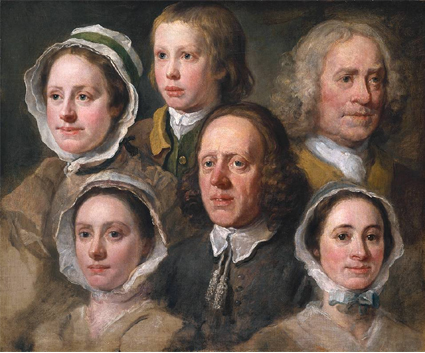The National Portrait Gallery’s fascinating exhibition, “Below Stairs: 400 Years of Servants’ Portraits”, closes at the end of today. So by way of encouragement to readers to get along if they can, this week’s picture is one of the star exhibits of the show: William Hogarth’s beautifully direct and dignified portrait of six of his servants. Their names are unknown, with the exception of one elderly servant named Ben Ives, who may tentatively be identified with the grey-haired, ruddy-cheeked man in the top right-hand corner of the portrait. These were not people, perhaps, of any great social consequence. But they have been painted with much more freshness and immediacy, and seem far more alive and interesting, than most of the glassy-eyed milords and miladies of eighteenth-century British art.
Hogarth completed the painting sometime in the early 1750s, presumably to hang in his own household, because he seems never to have offered it for sale. After his death in 1764 the work passed to his wife Jane, and following her death some 25 years later it was put up for sale with the rest of her collection, fetching the less than princely sum of £5 15s. Somebody got a bargain and the Tate Gallery, which still owns the work, had to pay rather more to secure it at the end of the nineteenth century. As Lawrence Gowing once memorably remarked, “there is nothing in Hogarth’s work, or anyone else’s, quite like the isolated masterpiece of his servants, the only picture that was ever solely and sufficiently united by what it is that humanity has in common.”
The painting may have had its origins as part of an experiment. According to a contemporary anecdote, at the start of the 1750s Hogarth was searching around for ways to reduce the sheer amount of...


